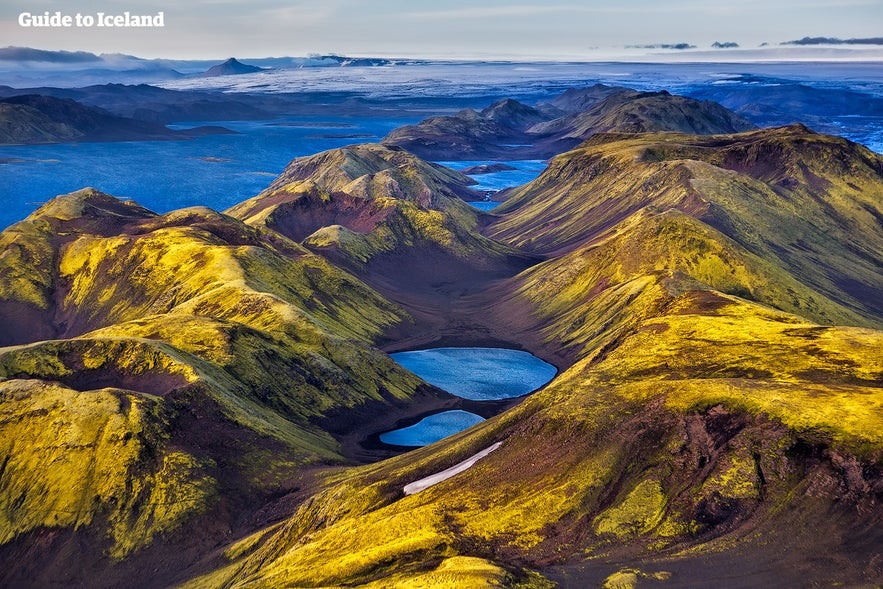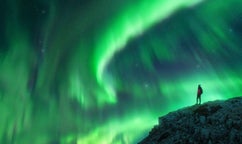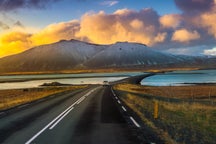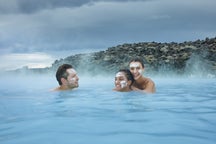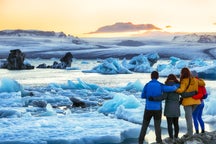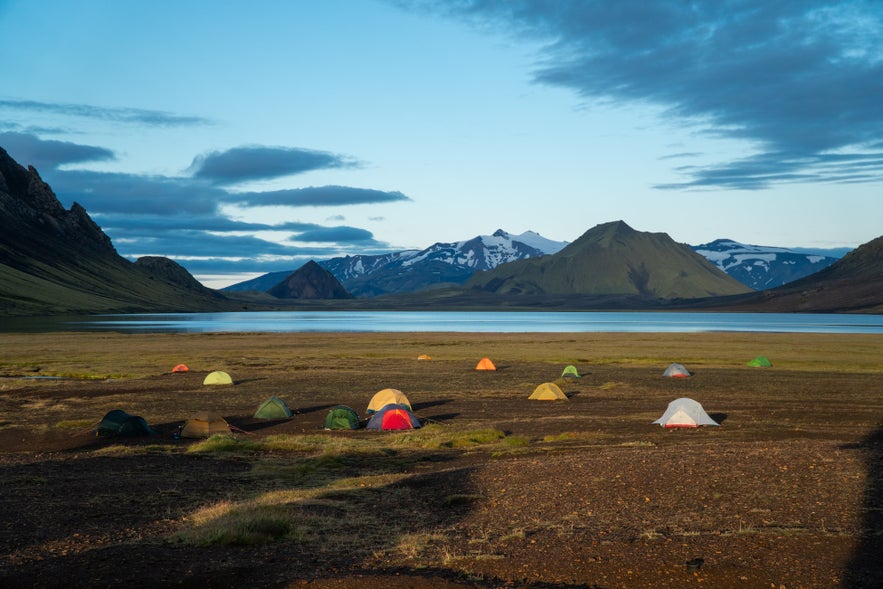
Explore Iceland’s captivating landscapes and untouched wilderness up close by getting out of town and camping in Iceland. Read on to find out how easy it can be to camp in Iceland, where to rent gear, what rules to look out for, and the best places to pitch your tent.
Iceland’s otherworldly landscape is a camper’s dream. Taking tours and visiting sites is one thing, but waking up to the sun rising over a fjord or falling asleep under the magnificent northern lights is another. If you’re ready to pitch your tent in the land of ice and fire, you’ve come to the right place.
With its unique wilderness and abundance of remote locations, Iceland can be the top location on any camper’s bucket list. Even if you aren’t an experienced camper, plenty of outfitters offer rental camping equipment to visitors. For tent-averse travelers, camper van rentals are another popular way to explore Iceland’s natural beauty.
However, to enjoy your trip to its fullest, you must consider the weather and laws around camping in Iceland. Read for answers to all your camping questions and the inside scoop on how to find the best camping experiences.
Photo above by Pavel Brodsky
Key Takeaways
-
Pre-book campsites and consider the Iceland Camping Card, especially during peak season.
-
Camp only in designated areas and adhere to Leave No Trace principles.
-
Pack for all conditions and check weather/road updates daily.
-
Factor in campsite fees, transportation, and potential gear rentals.
-
Enjoy the communal atmosphere while being considerate of other campers.
- Read about The Weather & Temperature in Iceland
- Get to know the essential Tips for Backpacking in Iceland
Can You Camp in Iceland?
Iceland offers several locations that allow for camping in tents and vehicles. Here’s a list of rules to take into account.
Wild Camping in Iceland is Limited
As Iceland has become a more popular tourist destination, the government has mandated that you cannot camp on uncultivated land without getting permission from the landowner. That includes parking on the side of the road and sleeping in your car.
No matter where you are in Iceland, whether you are camping in a tent, a van, or something else, you must spend the night in a designated campsite area.
There’s No Camping in Protected Areas
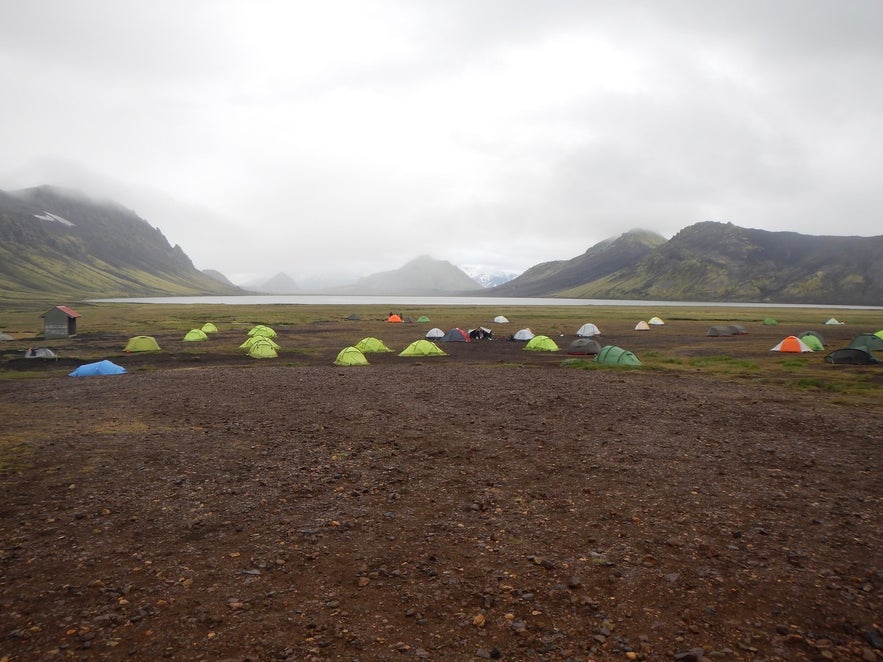 When camping in national parks — Thingvellir, Vatnajokull, and Snaefellsjokull — visitors must only camp in designated camping areas. It’s important to maintain Leave No Trace principles. That means no off-road driving and taking care not to disturb natural features like moss.
When camping in national parks — Thingvellir, Vatnajokull, and Snaefellsjokull — visitors must only camp in designated camping areas. It’s important to maintain Leave No Trace principles. That means no off-road driving and taking care not to disturb natural features like moss.
There are also many towns, natural landmarks, and sites where camping is prohibited. For example, camping outside designated campsites is forbidden in Alafoss, Dimmuborgir, Dyrholaey, Fjallabak, Hverfjall, Kirkjugolf, Myvatn, and Jokulsargljufur. For a comprehensive list, check out the Environment Agency of Iceland’s helpful page.
- See also: 24 Things Not To Do in Iceland
Pre-Book Your Campsite
Iceland campgrounds are very informal. Most operate on a first-come-first-served basis, and it’s rare for campsites to fill up.
That said, you may consider pre-booking your Iceland camping sites just to be safe, especially during peak tourist seasons near popular areas like the South Coast and Golden Circle. You can book your Iceland campsite through the Parka app, available for Android and Apple at Parka.is.
You may consider an Iceland Camping Card, which gives you access to many participating campsites for a 28-day period. The camping card covers two adults and up to four children under the age of 16. This secures you will have a camping spot while also allowing you the flexibility to change your plans as needed.
Multi-Day Guided Camping Tours
If you want the adventure of sleeping under the stars without the hassle of planning every detail, several multi-day tours include camping as part of the itinerary. These tours offer guided experiences that take you to Iceland’s most breathtaking locations while ensuring you stay at permitted campsites.
-
3-Day Hiking and Glamping Tour: Trek over 20 miles (35 kilometers) of trails in the Hornstrandir Nature Reserve.
-
4-Day Laugavegur Hiking & Camping Tour: Experience the Laugavegur Trail on this one-in-a-lifetime hiking tour.
-
4-Day Eldgja Trek Expedition through Iceland's Highlands: Explore the stunning landscapes of Landmannalaugar, Lake Langisjor, and the Eldgja Fissure over this 4-day expedition.
Where to Camp in Iceland
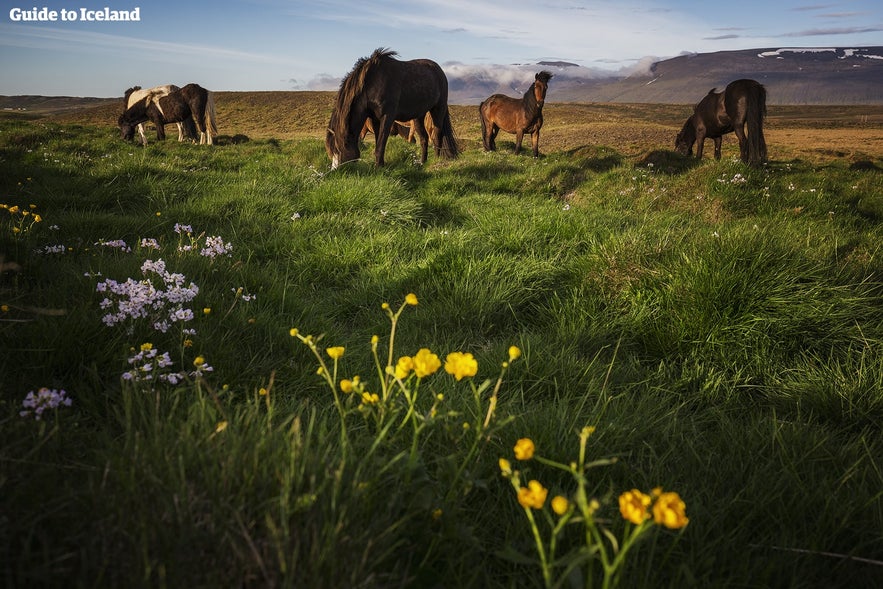
Thakgil campsite
Located about 13 miles (21 km) inland from Vik, Thakgil campsite has plenty of space, a stunning landscape, and access to several wonderful hikes. Like many campsites in Iceland, Thakgil has well-maintained facilities that can make your stay even more comfortable. The campsite has self-service charcoal grills, picnic tables, showers, bathrooms, and access to electricity.
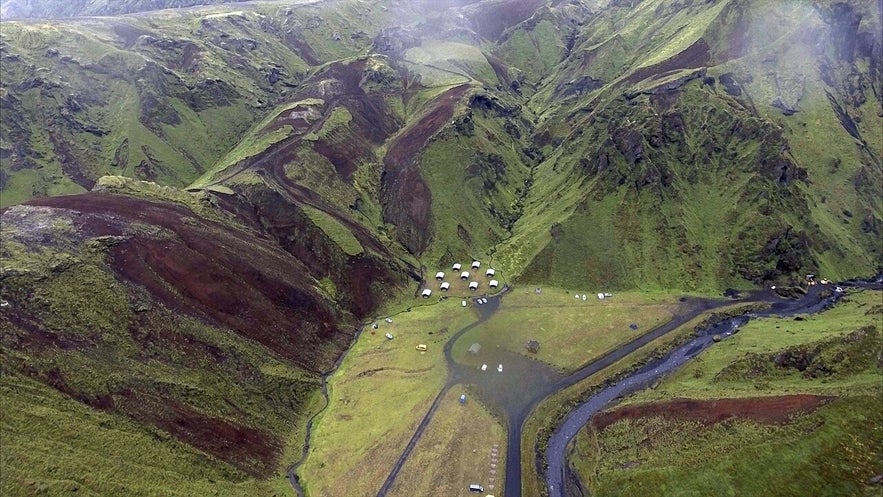
Photo from Wikimedia, Creative Commons, by Wojciech Strzelecki "Wojtrix".
Thakgil is perfect for all ages. With access to attractions like the Remundargil Canyon, Maelifell Volcano, and Austurafrettur Trail, advanced hikers will have plenty to keep them busy. Yet Thakgil also offers a playground at the campsite, making it perfect for families, too.
Note: Thakgil is open from June to mid-September. The road to get to the campsite can be rough. Bring a well-equipped 4x4 rental vehicle and take the journey slowly.
Consider adding some nearby day tours to your itinerary:
-
Horse Riding Tour on the Black Sand Beach from Vik: Explore one of Iceland's iconic South Coast black sand beaches on an unforgettable one-hour horseback riding tour.
-
The Katla Ice Cave Tour: Experience the magic of ice caving in Iceland with this hassle-free and thrilling way to explore Iceland’s incredible glaciers.
Svinafell Campsite
Located just off the Ring Road in Southeast Iceland, Svinafell campsite gives travelers amazing views of mountains and glaciers. It serves as the perfect base for exploring nearby attractions like Skaftafell National Park and Vatnajokull Glacier.
Svinafell provides several areas for tent camping. It also offers six heated cabins that can each hold up to four people in bunk beds. Additional sleeping bag space is offered in rooms holding up to three people with shared bathrooms and kitchen facilities. Guests all share a service center, called Skáli, which has common facilities for cooking, dining, showers, laundry, and toilets.
For tent camping, Svinafell is open from May through September. The sleeping bag rooms are available year-round except for certain holidays.
Interested in seeing the nearby national park and glaciers on a tour? Check out these options:
-
Ice Cave Tour in Vatnajokull Glacier: Explore one of Iceland's most amazing natural wonders on this adventure tour into the stunning Crystal Ice Cave within Vatnajokull National Park, starting from the Jokulsarlon Glacier Lagoon.
-
Beginner-Friendly Glacier Walk in Skaftafell on Vatnajokull Glacier: Reach new peaks with a guided tour that will take you hiking and climbing through the Skaftafell Nature Reserve.
Asbyrgi Campsite
Located in the horseshoe-shaped Asbyrgi Canyon in North Iceland, this campsite offers a tranquil setting of lush plant life and towering cliffs. It’s a great place to stay and explore the Asbyrgi region and the Jokulsargljufur Canyon.
This canyon is part of the Vatnajokull National Park and is home to the waterfalls of Dettifoss, Hafragilsfoss, and Selfoss. From Asbyrgi, you can access trails of any difficulty, from the gentle Botnstjorn Trail to the multi-day Canyon Trail that leads to the Dettifoss Waterfall.
Asbyrgi campsite is open from mid-May through October. Its facilities include electrical access, showers and restrooms, washing machines, and a playground. Tents, trailer tents, and caravans are all welcome at Asbyrgi campsite.
Take a day trip to see volcanoes and waterfalls in the area:
-
9-Hour Diamond Circle Tour with Lake Myvatn & Asbyrgi Canyon: Experience the volcanic landscapes and powerful waterfalls of the North.
-
1-Hour Airplane Tour over Asbyrgi Canyon & Dettifoss Waterfall: Soar above the region's beauty on this airplane tour starting from Lake Myvatn.
Hellissandur Campground
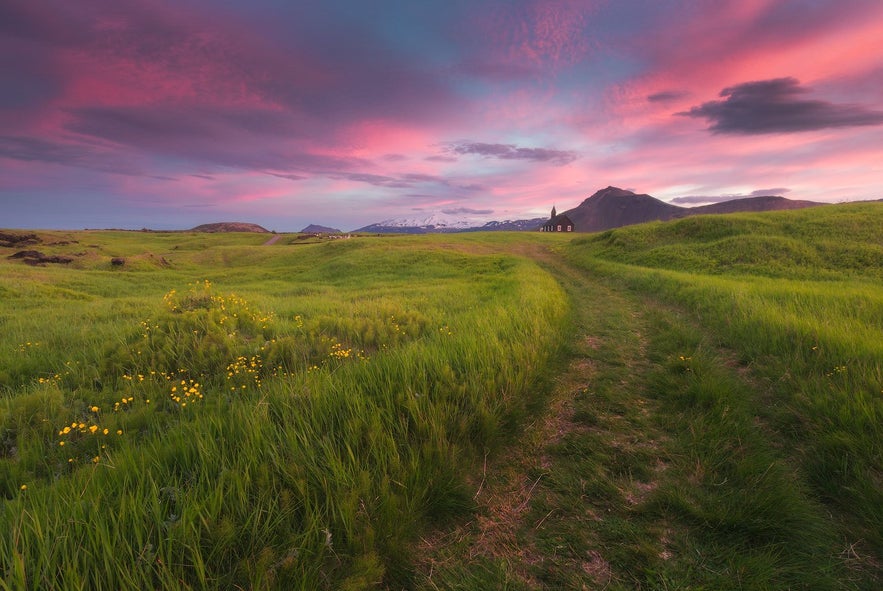
From the campsite, guests can access numerous trails that explore the unique lava fields and sandy beaches nearby. Sunsets here are exceptional!
Hellissandur campground is open from May through September. Its facilities include showers, a communal kitchen, a washing machine, and a playground.
Explore the surrounding area with these day tours:
-
Small Group Tour of Snaefellsnes Peninsula: See the most diverse area of the country, featuring volcanic beaches, black churches, and the world-famous Kirkjufell Mountain.
-
Snaefellsnes National Park Bus Tour: Take in “Iceland in Miniature” on this bus tour through the Snaefellsnes Peninsula.
Hallormsstadaskogur Campsites
On the other side of the country, in the Eastfjords, Hallormsstadaskogur National Forest offers a pair of campsites situated near the picturesque Lake Lagarfljot. The campsites provide access to over 25 miles (40 kilometers) of marked trails, an arboretum, and many recreational activities.
The facilities here are more advanced. In addition to showers, electrical access, waste disposal, an outdoor barbecue, and a playground, there is also a nearby hotel with an attached restaurant.
The Hallormsstadaskogur campsites operate from mid-May through September.

Campsites Across Iceland
These are just a few of the dozens of campsites dotting the entire island nation. Some of them are open year-round, even during the frigid winter months, while others are only accessible in summer. That said, it’s best to know before you go and be aware of the options available to you. Here is a complete list of available campsites in Iceland.
When to Book Your Iceland Camping Trip
When camping in Iceland, carefully consider the weather and the crowds. Iceland’s most popular tourist season lasts from late May to August. While campsites will be more crowded during this period, the weather will be better — warmer temperatures, longer daylight hours, and less rain, wind, and snow.
To get the best of both, you may want to book your campsites in Iceland during April at the very beginning of the high season or in September at the very end of the high season. Even then, you may experience much colder weather.
 Photo by Sonali Deo
Photo by Sonali Deo
Iceland Camping Costs and Budgeting
Camping is a great way to explore Iceland while saving on costs. However, there are costs you should plan for. Please note that the prices and conversions listed may fluctuate.
Campsite Fees in Iceland
Most camping spots in Iceland charge per person, typically between 11-14 USD (1,500-2,000 ISK) per person, per night. Some campsites may charge extras for amenities like electricity, washing machines, and showers. This can add around 4-8 USD (500-1,000 ISK) per night.
Transportation Costs in Iceland
If you’re tent camping in Iceland, you’ll need a plan for how to get around.
-
Renting a car may be the most convenient option, as you can go at your own pace and access practically any campsite. Economy cars can cost between 50 USD and 60 USD per day. SUVs can cost around 80 USD per day, and larger vehicles like minivans may cost nearly 200 USD per day. Insurance may add between 20 and 40 USD per day.
-
The Highland camping bus runs a route during the high season that delivers campers directly to major campsites, mainly along the Ring Road. With several options under 100 USD, this option can save costs and headaches.
-
Camper vans are a popular option for camping in Iceland. They offer better shelter against the unpredictable weather, and they ensure you have access to heat, electricity, and comfort. Small to medium camper vans can cost up to 130 USD per day, without considering insurance and fuel.
Iceland Camping Gear Rental
Campers may need to consider renting extra gear to stay comfortable through Iceland’s unique weather and experiences. In addition to low-temperature sleeping bags, cooking kits, and more, these items can cost up to 50 USD per day.
You don’t have to haul your camping gear to Iceland, thanks to these helpful gear rentals:
-
Stay dry in a one- or two-person light tent.
-
A four-season sleeping bag to keep you warm no matter when you travel.
-
Sleep in comfort with a self-inflating mattress.
-
Brave the weather with a waterproof jacket and pants.
-
Keep your feet happy in heavy-duty sports boots.
-
Stay upright, even on rocky terrain, with rental walking poles.
Iceland’s Camping Culture
Iceland is known for its natural beauty. Most visitors come to Iceland to experience it. Iceland’s camping culture makes it easy to make new friends, especially since so many travelers and campsite staff speak English as a second language.
Most campsites have communal kitchens, dining areas, and outdoor spaces, so it’s easy to strike up conversations. Travelers often share tips about camping recipes, hikes, and routes.
Camper van travelers talk about routes and work together to fix minor vehicle problems. Photographers and visitors hunting the best aurora view share their techniques and experience. In the summer, the midnight sun keeps people active and social late into the night, with conversations and even hikes.
If you prefer solitude, that’s fine, too. Travelers camping in Iceland are very considerate and keep noise levels low, especially at night.
- See also: Travel Etiquette in Iceland
Camping Safety Tips in Iceland
Iceland is a sparsely populated country with huge pieces of uninhabited land. While this is part of Iceland’s magical appeal, it can leave you stranded if you go unprepared.
-
Get comfortable with your camping equipment.
If you’re new to camping or using new gear for the first time, get a few practice rounds setting up your tent and using your camp stove before your Iceland camping trip. -
Be realistic about long distances between campsites.
Make sure you travel with enough food and water. Keep your phone charged. Make sure you have enough fuel to get where you’re going. -
Prepare for all kinds of weather.
Even in the summer, Iceland's temperatures can drop close to freezing, so bring a four-season sleeping bag and thermal layers to stay warm. Iceland’s wind can be intense, so use a strong, wind-resistant tent with strong pegs. Secure your gear at night so it doesn’t blow away. Weather can change quickly, so check the Iceland weather forecast for real-time weather updates before heading out each day.
-
Account for limited daylight.
The winter months have fewer daylight hours. Plan your activities accordingly so you don’t get stuck hiking in the dark.
-
Respect the roads and trail paths.
The weather can severely affect the road conditions, especially during winter, so check road conditions regularly. Some campsites require travel on highland roads (F-roads), which need a 4x4 vehicle. If hiking near glaciers, waterfalls, or hot springs, stay on marked trails to avoid dangerous terrain.
-
Be prepared for emergencies and safety.
Make sure to pack waterproof and windproof gear, headlamps and flashlights, and power banks to charge your devices. Save Iceland’s emergency number (112) in your phone. -
You may also rent a personal locator beacon, a Garmin GPS Map or use the SafeTravel app for safety updates to leave a travel plan for longer trips. Always let someone know your travel plans, especially when camping in remote areas.
FAQs About Camping in Iceland
These are the most frequently asked questions about camping in Iceland.
1. Is wild camping allowed in Iceland?
No, wild camping is heavily restricted in Iceland. You must stay in designated campsites unless you have explicit permission from a landowner to camp on private land. This applies to both tent campers and camper vans.
2. What is the best time of year to camp in Iceland?
The best time for camping is between late May and early September when the weather is milder, days are long, and most campsites are open. Winter camping is possible but requires extra preparation due to harsh weather and limited daylight.
3. Do I need to book campsites in advance?
While many campsites operate on a first-come, first-served basis, pre-booking is recommended during peak tourist season (June–August), especially near popular destinations like Reykjavík and the Golden Circle. The Parka app is a useful tool for booking campsites.
4. What is the Iceland Camping Card, and is it worth it?
The Iceland Camping Card grants access to participating campsites for up to 28 days and covers two adults and up to four children under 16. It’s a great deal if you plan to stay at multiple campsites, but always check if your preferred campsites accept it before purchasing.
5. How much does camping in Iceland cost?
-
Campsites charge 11–14 USD (1,500–2,000 ISK) per person per night.
-
Extra fees apply for showers, electricity, and laundry.
-
Renting a camper van can cost 130+ USD per day, while tent camping is more budget-friendly.
6. What gear should I bring for camping in Iceland?
-
Four-season sleeping bag (temperatures can drop, even in summer).
-
Windproof and waterproof clothing (Icelandic weather is unpredictable).
-
Sturdy tent and pegs (strong winds are common).
-
Cooking equipment (not all campsites have kitchens).
-
Power bank (limited charging stations at some campsites).
7. What safety precautions should I take while camping?
-
Check vedur.is for weather updates before heading out.
-
Check road.is for road conditions, especially for Highland (F-road) travel.
-
For safety, avoid camping near cliffs, glaciers, or hot springs.
-
Use the SafeTravel app and inform someone of your itinerary.
-
Iceland’s emergency number is 112.
8. Are there facilities at Icelandic campsites?
Most campsites in Iceland offer:
-
Toilets & showers (some charge extra)
-
Communal kitchens & picnic tables
-
Electrical access (for an additional fee)
-
Laundry facilities (at select locations)
Camping Around Iceland – the Adventure of a Lifetime
Camping in Iceland is an unforgettable experience. The nation’s beautiful fjords, majestic mountains, lava fields, and black sand beaches are unlike anywhere else on Earth.
At the same time, camping in Iceland is easy with a little planning. Even in the high tourist seasons, crowds aren’t overwhelming, and navigating from one campsite to the next is fairly straightforward. No matter how you choose to bring your camping dreams to life, camping in Iceland offers wonder after wonder.
Leave your questions about camping in Iceland in the comments section. Already a camping expert? Tell us about your Iceland camping experiences below!


